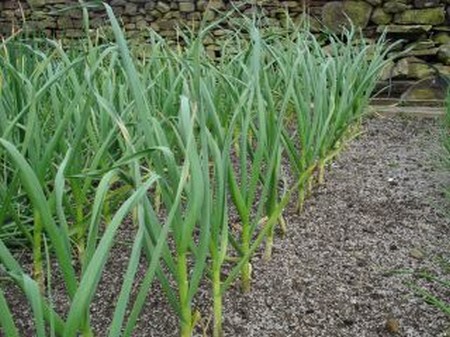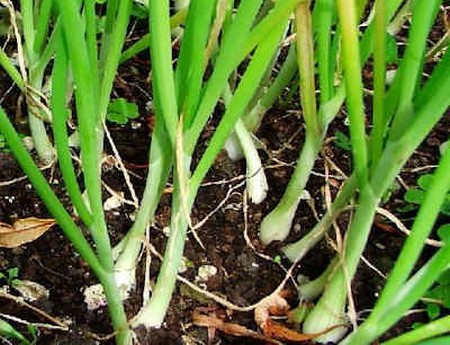Spring onions (scallions) are small onions that are eaten fresh; they are not dried. They produce small bulbs that are little more than a slight swelling at the base of the stem. The bulb and the base of the stem is white; the cylindrical leaves are green. A young form of large, bulbous onions, they originate from the same part of the world, Central Asia. They are called spring onions (scallions) because they are ready to eat in spring, unlike other onions, which do not mature until later in the year.
The Welsh onion is similar to spring onions (scallions) but derives from a different species, Allium fistulosum. It has little to do with Wales, since it has been introduced to the West only relatively recently, although it has been in cultivation in China since prehistoric times. It found its way westwards through Russia in the early 17th century, possibly picking up its name from the German welsche (foreign) on the way. Welsh onions are somewhat coarser in appearance than spring onions. They are perennials, rather like coarse chives, and the foliage can be used in the same way as that of chives.
Bunching onions are similar again and have been derived from Welsh onions. These can be used as annuals, like spring onions (scallions), or as perennials, like Welsh onions.
Spring onions (scallions) can be used in cooking but they are more frequently eaten raw, especially in salads. The leaves can be used as a substitute for chives, and the onions themselves are often used as a garnish. Welsh and bunching onions are used in much the same ways.
Main gardeners use shallots for pickling. However, there is also a special type of pickling onion (also called a cocktail onion) that can be grown. These are similar to spring onions (scallions) except that the bulb develops more fully. They are small, white-skinned onions. Like spring onions, they are grown from seed sown in the spring and are usually ready for harvesting after two months. They are treated in the same manner as spring onions and can be left unthinned for smaller bulbs or thinned for larger ones. The smaller ones can be used as a substitute for bulbous spring onions. Although usually pickled they can be stored like other bulbous onions.
Cultivation
Like the rest of the family, spring onions (scallions) need an open, sunny site. The soil should preferably be light, but they will grow in most soils as long as they are manured. Dig in manure in autumn for spring sowing. Sow the seed in spring and then at three-week intervals for a succession. Late summer sowings can be overwintered under cloches for an early spring crop.
Sow thinly in drills l cm deep and 15-20cm apart. It sown thinly enough, there should be no need to thin. This is important because the smell of bruised plants that is caused by thinning attracts onion fly.
Spring onions (scallions) should be grown quickly or they become tough, so they will need watering in dry weather. Welsh onions are grown in the same way but should be left in situ – only the leaves are cropped. Lilt and divide every few years when the clumps get congested.
Harvesting
Spring onions (scallions) are ready for use at about eight weeks from sowing. Simply pull them from the ground. If the soil is compacted, they can be eased out with a hand fork.
Storage
Spring onions (scallions) cannot be stored for more than a few days. Keep in a cool place or in a refrigerator. The leaves can be chopped and frozen, either in bags or in ice cubes, for use in winter in the same way as chives.
Pests and diseases
The main pest is onion fly, whose maggots eat the onions, turning the leaves yellow and eventually killing them. The dangerous period is when the onions are damaged by thinning or weeding because the flies smell the odour that is given oil. Burn or destroy any affected onions. Onion eelworm produces distorted leaves. Again, burn or destroy affected plants.
Various fungal diseases can affect spring onions (scallions) but because their life is so short an) diseased plants should he destroyed and a fresh start made in a new position in the garden.

